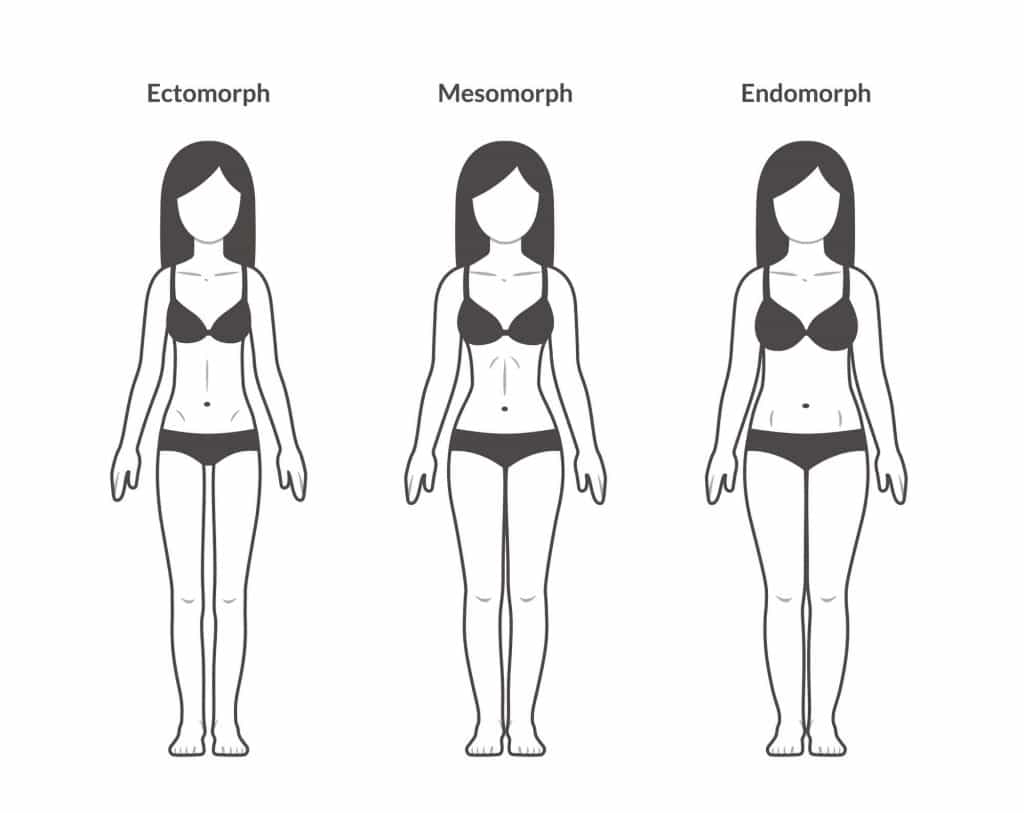Determining Your Somatotype for the Best Hashimoto’s Diet {{for you}}
If you search the internet for the most popular Hashimoto’s diet from over the last few decades, you will find suggested eating plans based on anything from food point values to blood types. Other dietary theories promote the elimination of specific food groups. One consideration as it relates to nutrition and one I find interesting especially for people with Hashimoto’s, hypothyroidism or adrenal fatigue is one that is based on body type (otherwise known as somatotype). This concept was proposed nearly 80 years ago.
Dr. William Sheldon introduced the idea of somatotypes during the 1940s. His theory suggested that people genetically inherit a specific body type which he classified by measuring both body fat and skeletal markers. A person was either an ectomorph, a mesomorph or an endomorph. He believed this body type was static and could not change over time. Sheldon developed this method to determine a person’s temperament by visually observing that person’s body.
According to Sheldon’s classifications, ectomorphs are naturally skinny or slender in appearance, with smaller bones and narrow shoulders and hips. Mesomorphs are relatively lean and muscular, having broad shoulders and wedge-shaped bodies. Endomorphs are short and round with a higher body fat content and broad shoulders and hips.
While scientists of the day debunked somatotype based temperament assessments, Sheldon’s assistant, Barbara Heath, developed a more scientific and usable system when she combined her research with that of Lindsay Carter. The Heath-Carter method was born, with one of its highest uses to predict and document the progression of college athletes.
By its application alone, it is evident the Heath-Carter method determined that body types are changeable due to aging, growth, exercise and dietary deprivation. The approach also goes beyond the standard three body types first proposed by Sheldon, allowing for those measured to fit into subcategories with combinations of the three. These determinations included a series of measurements including weight, height, skeletal bone lengths, muscular diameters and skinfold thickness assessment.
More recently, Dr.Nikolas Hedberg (2015) has presented his work regarding thyroid disorders and somatotype to various institutions and training events for clinicians. I first heard Dr. Hedberg lecture on this topic via a round-table clinical presentation for Designs for Health. Based on hundreds of lab tests, the clinical treatment of patients, and documented nutrition studies, Dr. Hedberg noted a few key observations regarding the three somatotypes and how these relate to thyroid and adrenal health.
HOW DO YOU KNOW WHAT YOUR BODY TYPE IS?
To find your body type, take your middle finger and thumb and wrap it just above the wrist bone on the opposite hand. If your fingers overlap, you’re an ectomorph. If your fingers touch, you’re a mesomorph; and if your fingers don’t meet, you’re an endomorph.
THE ENDOMORPH BODY TYPE
Endomorph body types are the group most likely to suffer from hypothyroidism. They are highly carb sensitive and can easily become insulin resistant. Endomorph body types do best to eat a diet lower in carbs, in the range of 50-100 grams per day and more fat. They do best to augment caloric deficit with healthy fats instead of too much protein, which can also metabolize into sugar in the bloodstream. With a low functioning thyroid, it’s important to balance free circulating glucose as well as to provide the body with enough calories so it doesn’t further slow metabolism believing it’s in survival mode.
Key Characteristics:
- Accumulates body fat very easily
- Slow metabolism – has difficulty losing weight
- Usually “short and stocky”
- Soft and round body
- Gains weight & muscle mass very easily
THE ECTOMORPH BODY TYPE
Ectomorph body types tend to have healthy thyroid function but compromised adrenals because they are highly susceptible to stress. Dr. Hedberg found that this body type functions best by following a diet of more carbohydrate and less fat intake. Also, those with adrenal fatigue if left unchecked may trigger hypothyroidism.
Key Characteristics:
- Lean muscle tissue
- Fast metabolism
- Slender, skinny
- Small breasts or flat-chested
- Weight gain is not usually an issue
THE MESOMORPH BODY TYPE
If you are in the middle and fit the mesomorph body type, you can have a higher intake of both carbohydrate and fat as long as they are balanced. Mesomorphs tend to have a healthy functioning thyroid and adrenals. However, the right nutrition and lifestyle balance are always key. Eating too many calories, or the wrong balance of macronutrients can also lead to the accumulation of body fat just as easily as you build muscle.
Key Characteristics:
- Naturally strong
- Muscle definition – “hard body”
- Athletic type, rectangular shape
- Broad shoulders
- Easily gains muscle
- Easily gains fat (more so than ectomorphs)
Finally, to know and understand your body type is an interesting concept to consider for nutrition purposes. As I’ve been saying for years, there is no “one size fits all” thyroid or Hashimoto’s diet. We are all unique and have varying food sensitivity issues (it’s important to get tested for these). So, if you have been following any popular or broad-based diet recommended for people with Hashimoto’s hypothyroidism and you’re not experiencing the success in your health that you had hoped for, you may want to consider an eating plan based on your unique somatotype.
Resources:
LiveStrong has some excellent ideas for meal plans based on somatotype and is a good place to start so you can begin with your custom Hashimoto’s diet based on your unique body type. In addition, you may find the following resources helpful:
[amazon_link asins=’B00QQK8GKE,B00Q5RTT0O,B00CDH0KK8,B00IIWWS84′ template=’ProductGrid’ store=’https://affiliate-program.amazon.com/home/account/tag/manage?tracking_id=thyroidcare-20′ marketplace=’US’ link_id=’85e8d90d-8e8a-11e7-8cf6-597900edabaa’]
[amazon_link asins=’0778805042′ template=’ProductGrid’ store=’https://affiliate-program.amazon.com/home/account/tag/manage?tracking_id=thyroidcare-20′ marketplace=’US’ link_id=’c5ca457b-8e8d-11e7-a688-57460a7d554a’]
References
- Hedberg, D. N. (2016, August 27). The Best Thyroid Diet. Retrieved August 28, 2017, from https://drhedberg.com/the-best-thyroid-diet/
- Know your body type (somatotype) – mPort – Blog. (2017, June 19). Retrieved August 29, 2017, from https://mport.com/blog/know-your-body-type-somatotype/
- The ectomorph body type (somatotype) – mPort – Blog. (2017, June 18). Retrieved August 29, 2017, from https://mport.com/blog/ectomorph-body-type-somatotype/
- The mesomorph body type (somatotype) – mPort – Blog. (2017, June 18). Retrieved August 29, 2017, from https://mport.com/blog/mesomorph-body-type-somatotype/
- The endomorph body type (somatotype) – mPort – Blog. (2017, June 18). Retrieved August 29, 2017, from https://mport.com/blog/endomorph-body-type-somatotype/
- Venuto, T. (n.d.). Once an Endomorph Always an Endomorph? (Can Your Body Type Change?). Retrieved August 30, 2017, from http://www.burnthefatblog.com/once-an-endomorph-always-an-endomorph-can-your-body-type-change



